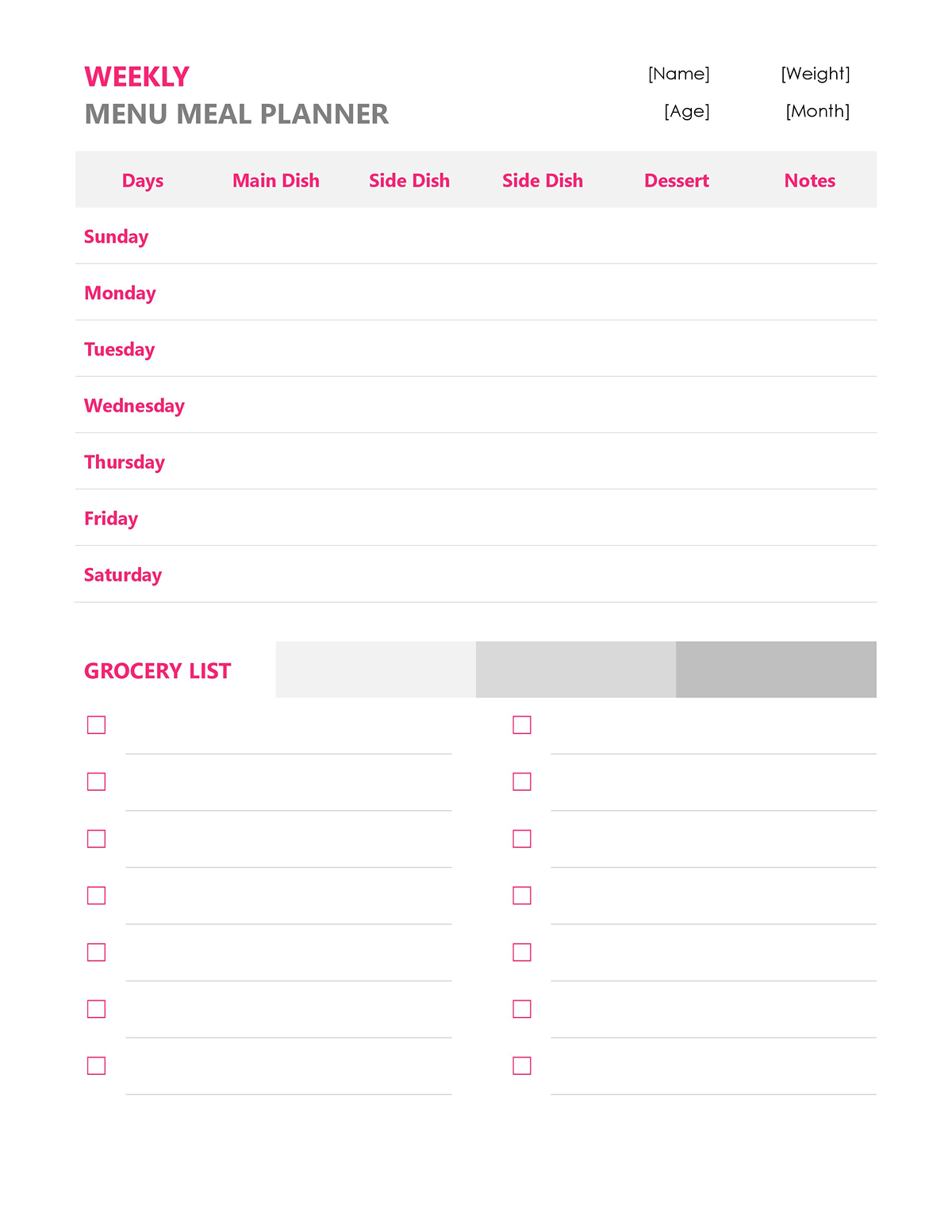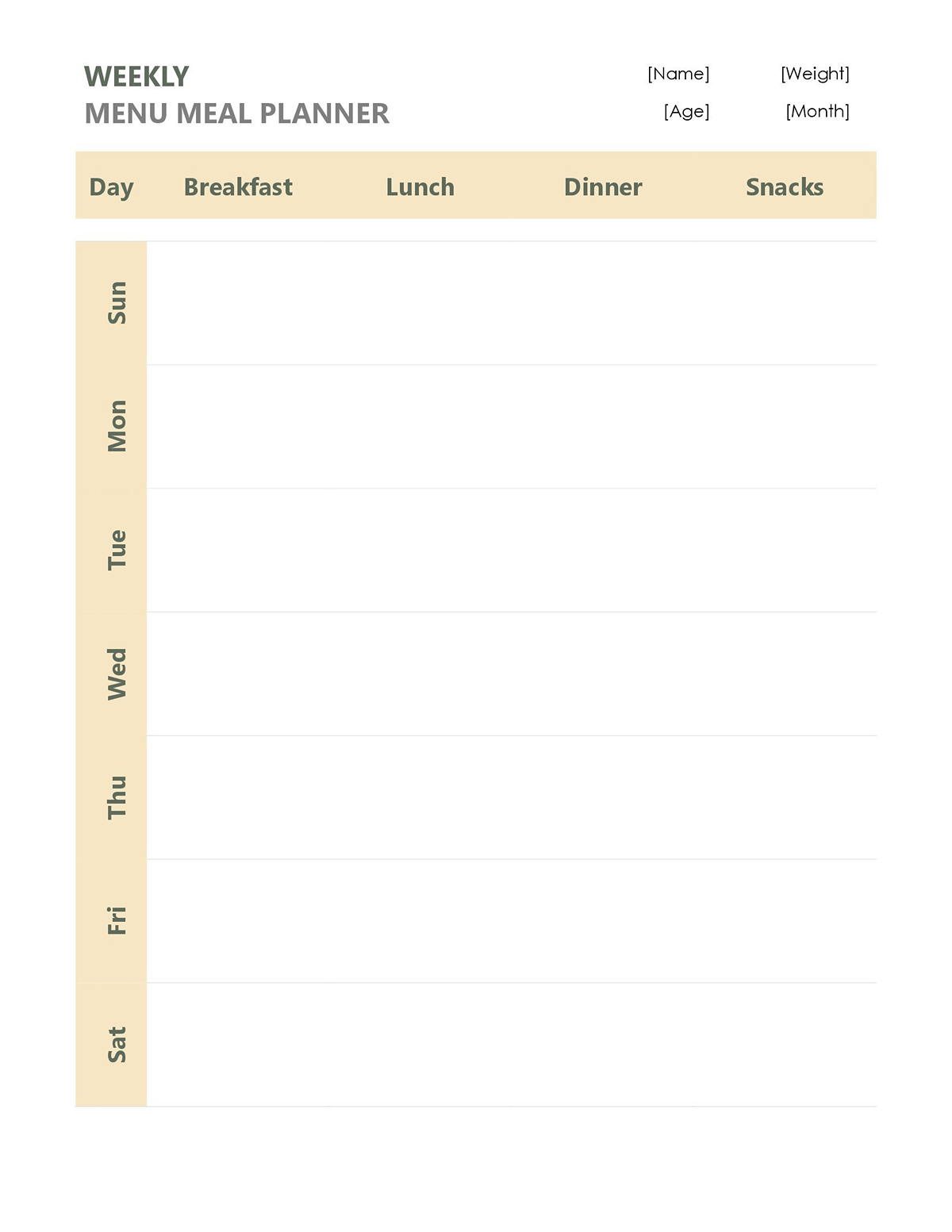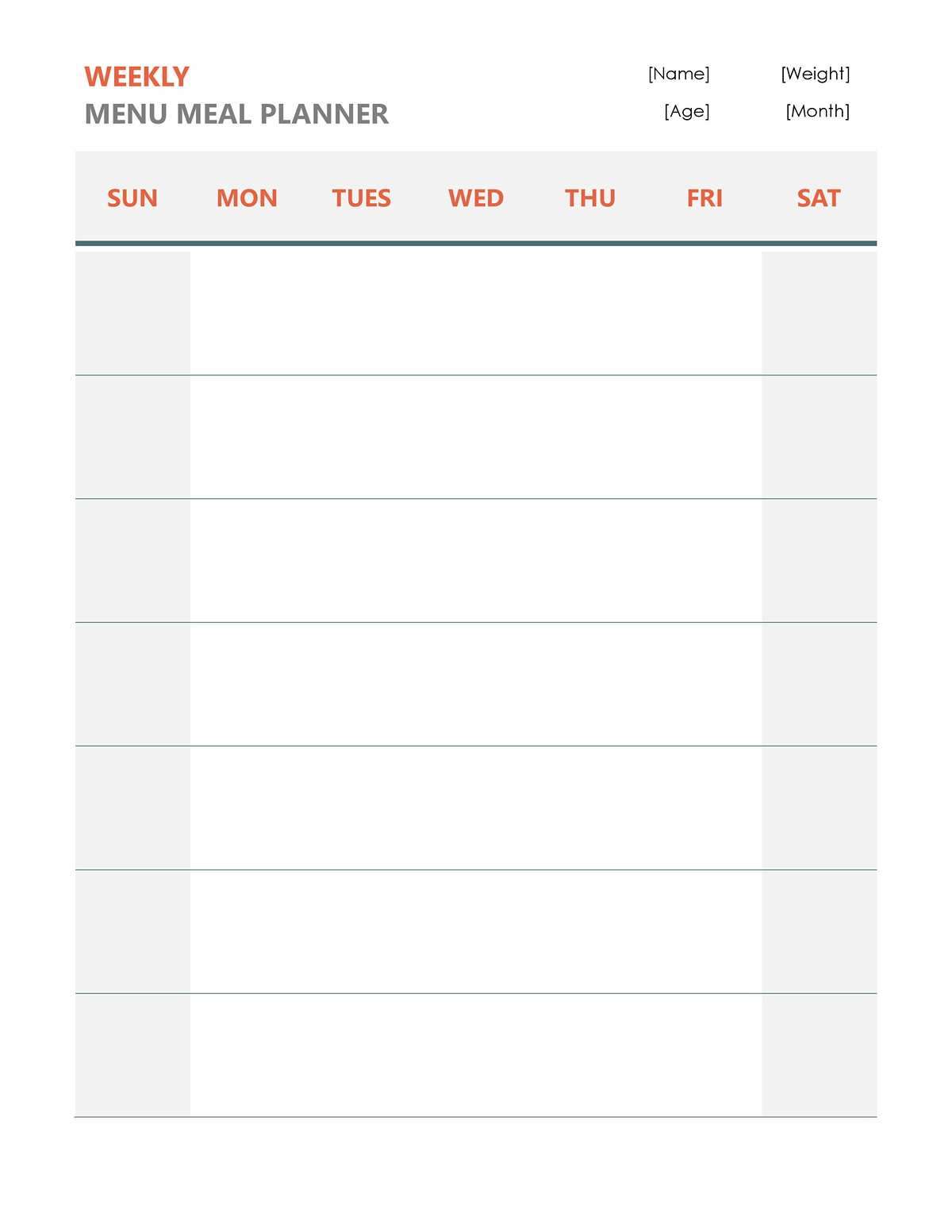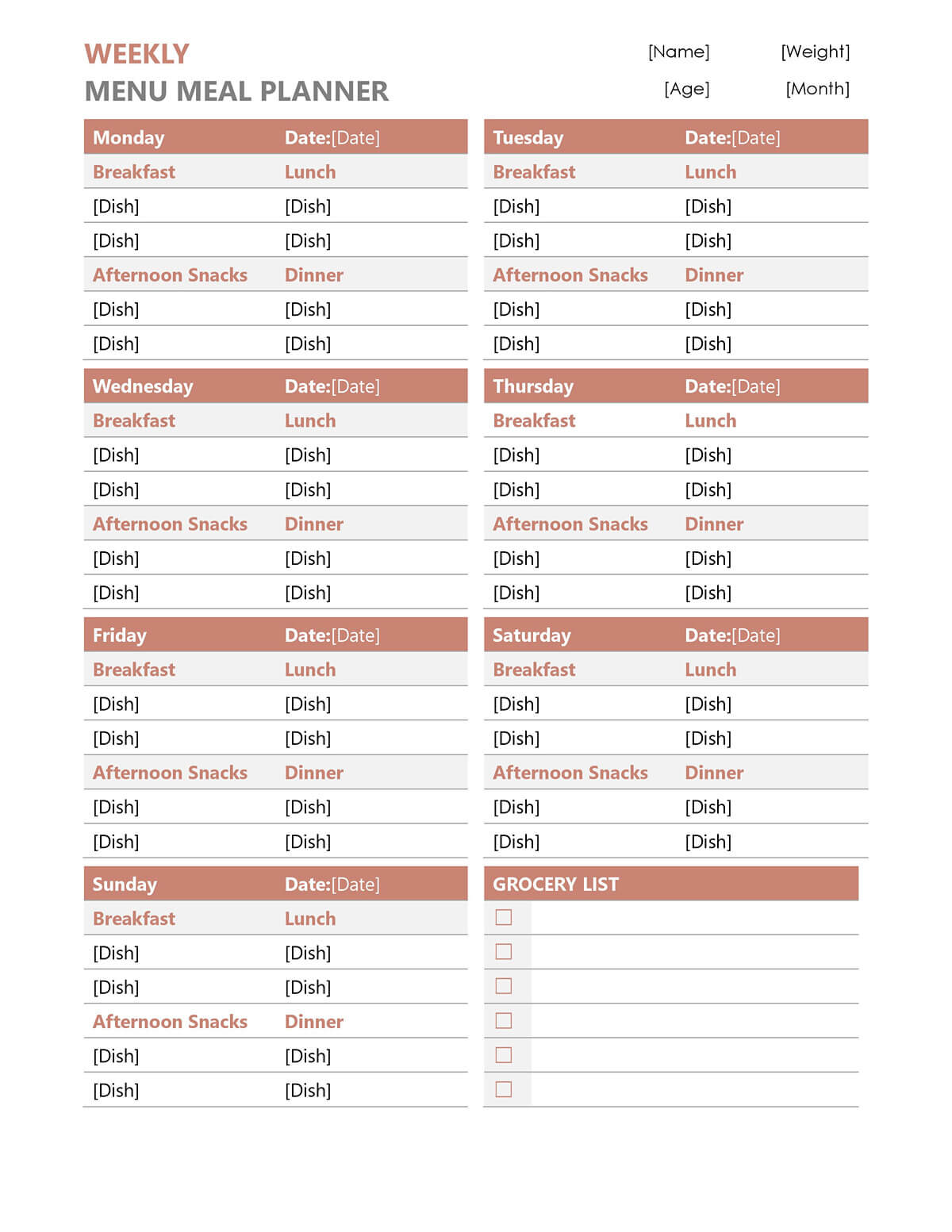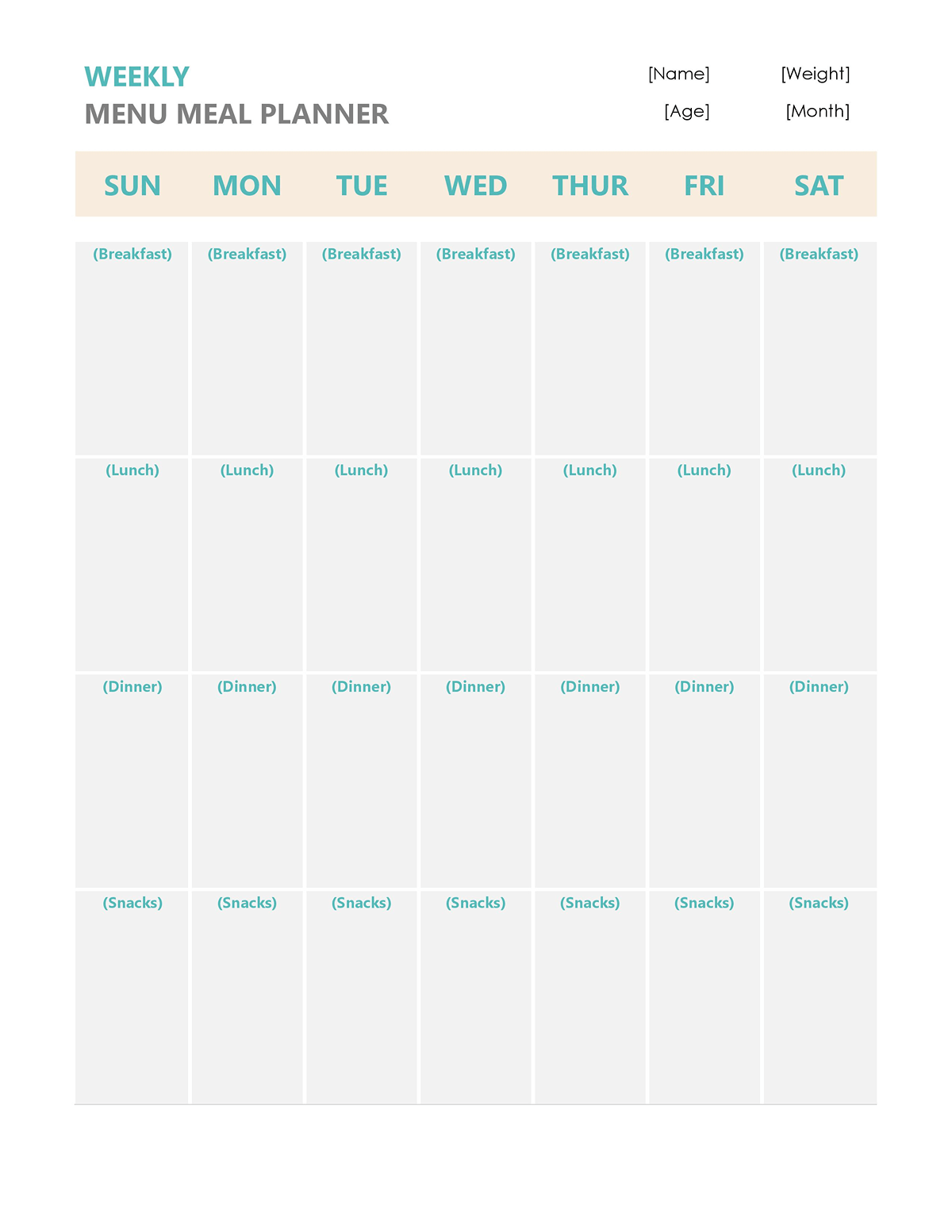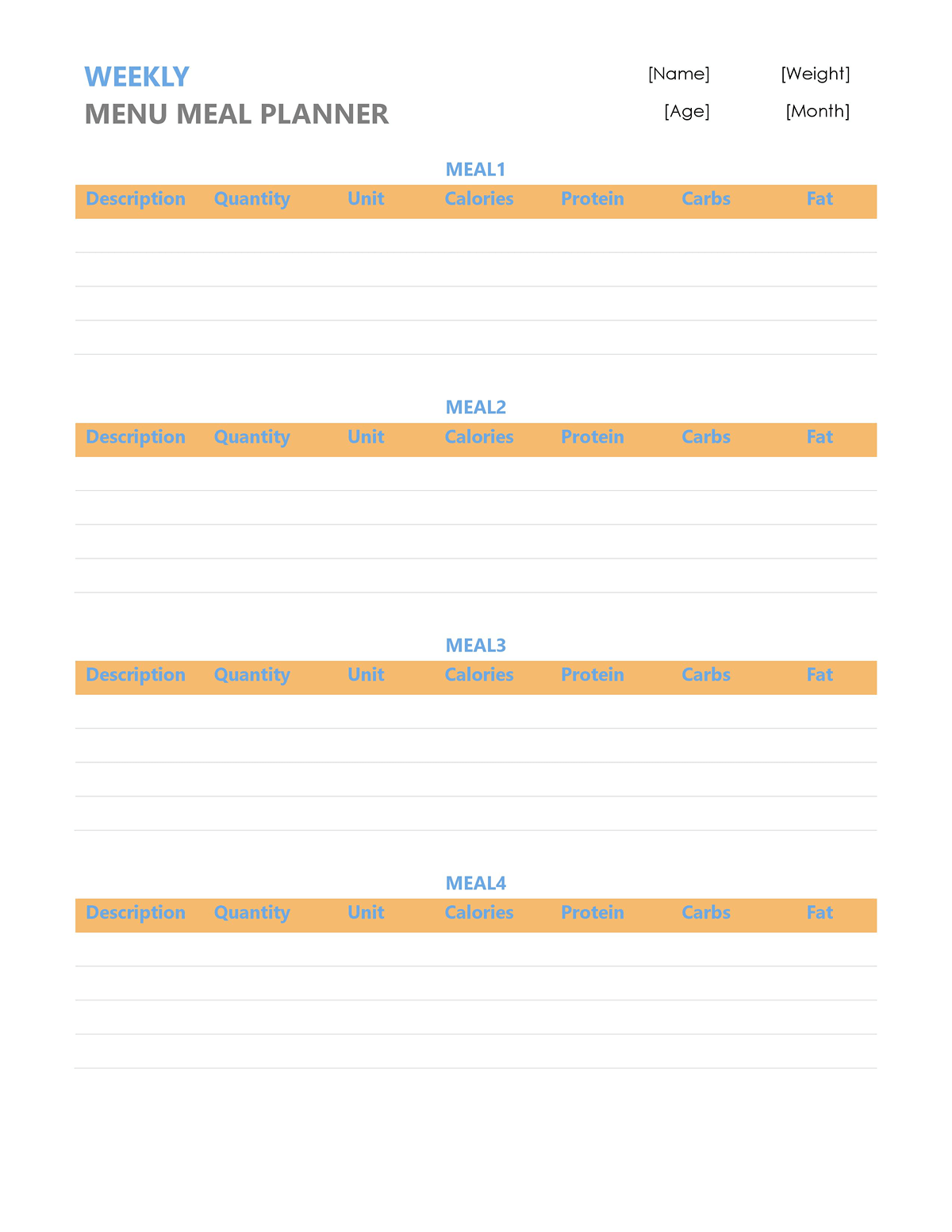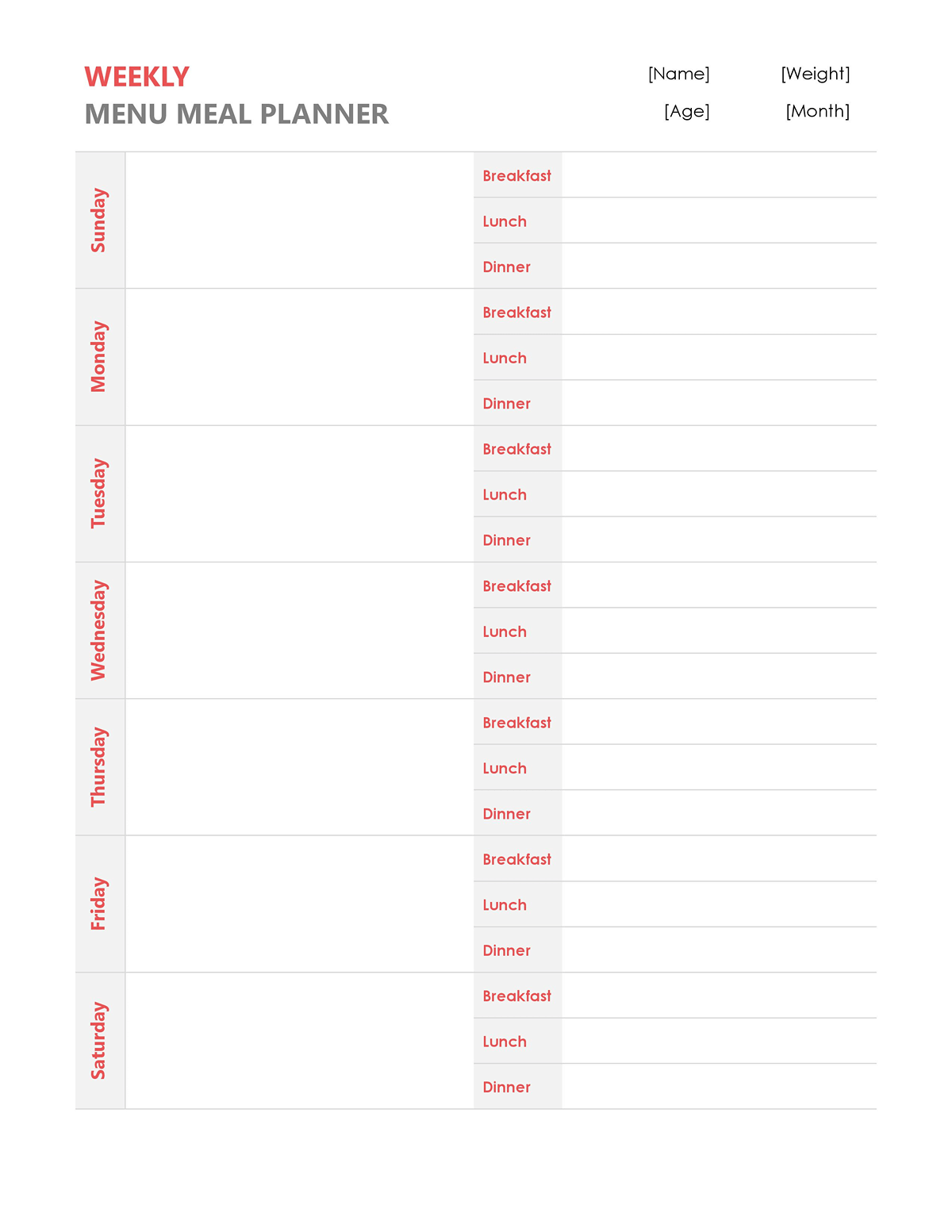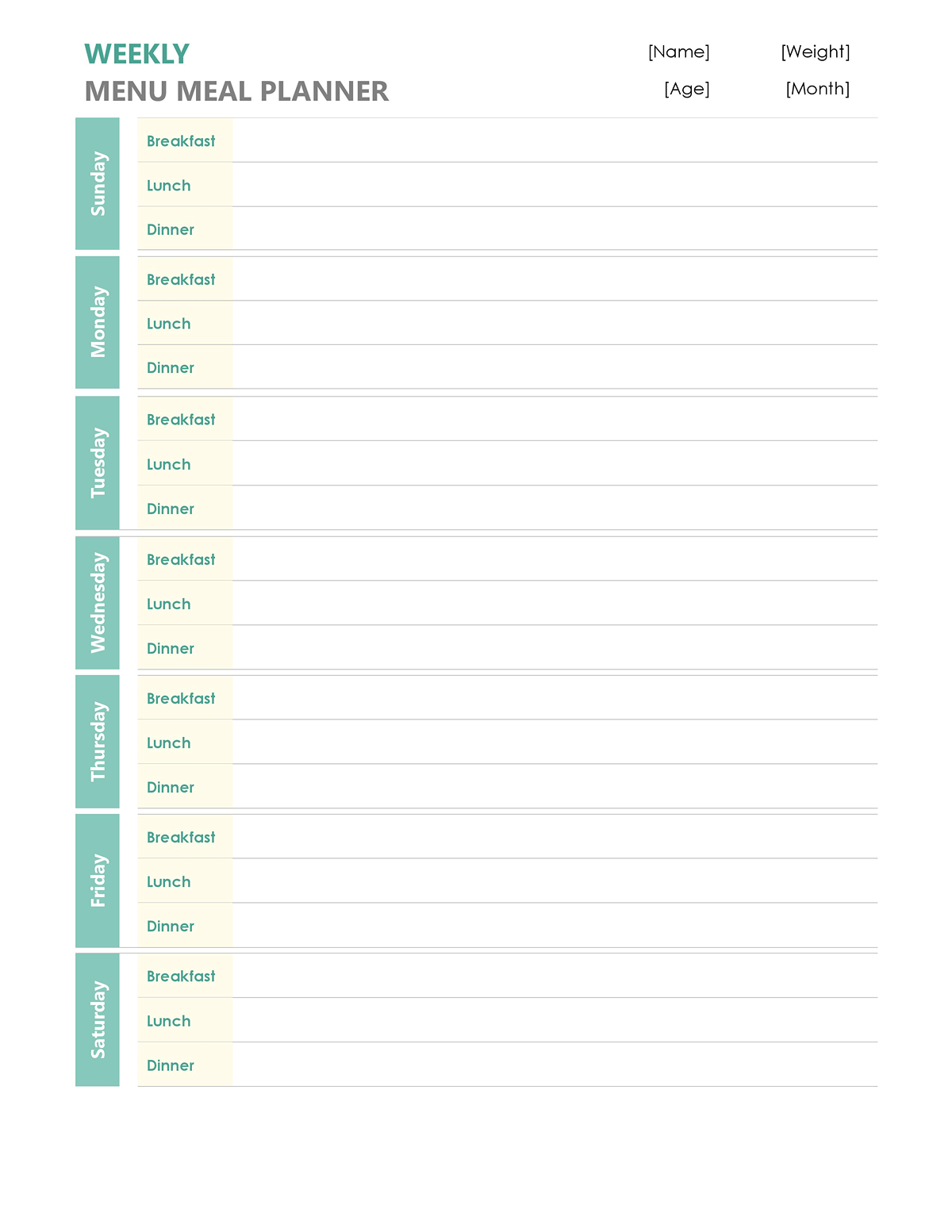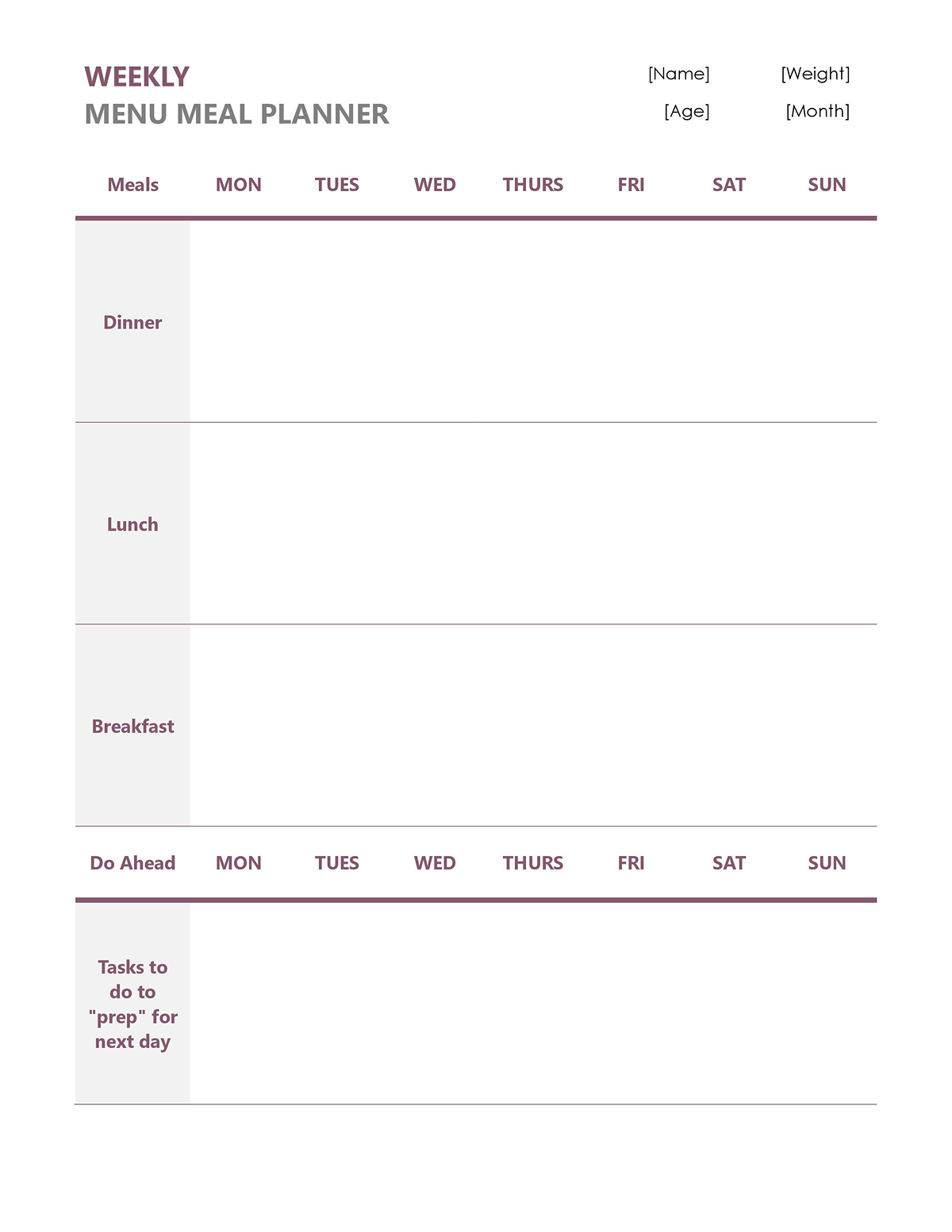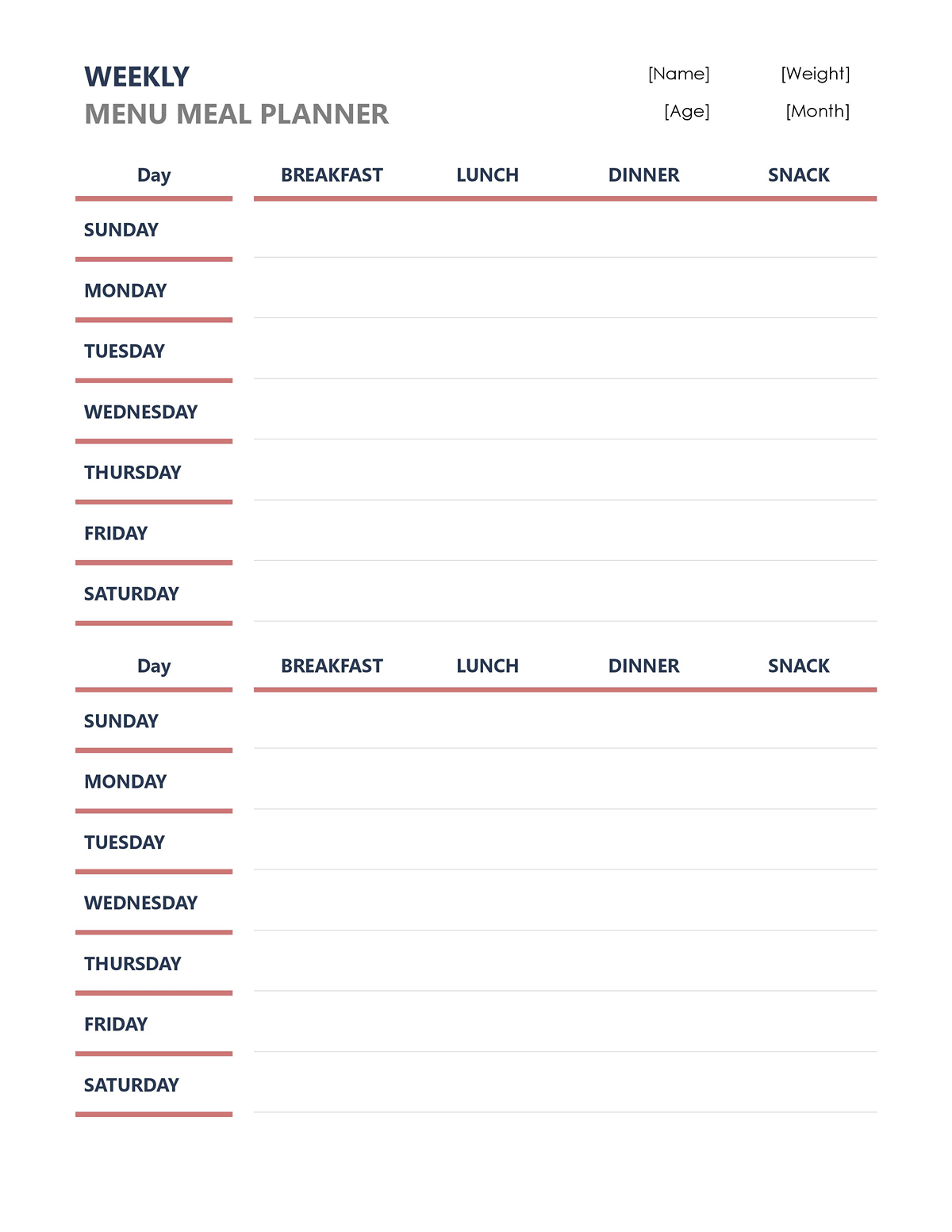A meal plan is a schedule of the meals a person eats over time, for example, weekly or monthly. A plan contains different meal options for breakfast, lunch, and dinner. The plans are made for various purposes, including maintaining diets or achieving nutritional goals for people trying to manage their health conditions. They are helpful for professionals like athletes who need to adhere to specific physical requirements.
Meal Plan Templates
Following are the meal planner templates that you can download for free:
Persons with diseases like diabetes need meal plans outlining healthy nutritional options. They can also be made for fitness purposes. The plans may also include water, nutrition, and calorie intake specifications. For people trying to manage medical conditions, it is advisable to make a meal plan with the help of a dietitian. They help you to manage your health by monitoring your intake. They can also be used with a budget to help regulate your finances. The overall goal of having a meal plan is to avoid disorganization when planning for future meals.
Tip: Meal plans are usually in the form of a template listing meals to be taken throughout the day. They may be made to suit individual preferences or with the help of a dietician. Meal planning is selecting meals to be cooked in advance, considering your schedule. With meal planning, one has to go shopping to buy the required items; it may also require your family’s input. Meal planning also considers seasonal food items; therefore, it must be adjusted to accommodate seasonal changes.
Why is it Needed?
Meal plans offer many benefits. They can be used to reach health goals like weight loss or muscle gain. Some of the benefits of having a meal plan include the following:
It saves time
They are a helpful tool for busy days. For working parents, for example, having a meal plan for breakfast helps reduce the time spent deciding what to eat. They can also be used to determine dishes or snacks to be prepared. With a recipe in mind, food items required for meals are chosen in advance and stocked in the pantry for when they will be used. With a meal plan, ingredients used during the week, for example, onions, carrots, and tomatoes, can be chopped and refrigerated to save time when cooking.
Saves money
A plan in advance helps save money by cooking at home. Any leftovers can be frozen and eaten at another time, reducing wastage. Further, an elaborate plan reduces the need to order or eat food from restaurants. The initial cost may be expensive but having food in the house reduces the need to travel and drive to restaurants.
It enables you to have control over food
Control over food intake is essential for people seeking to maintain their health. They help you determine the right amount of food you should take in one sitting. They also help you keep track of the type of food you are eating. With it, you can actively reduce snacking in favor of healthier meals. In addition, by pre-selecting meals, you control what you will eat throughout the plan, which helps you stick to more nutritious choices and achieve the goals set for your plan.
Brings organization to eating plan
Being organized helps to save time, money, and resources. A meal plan is a helpful organization tool as it helps you maintain your weekly cooking schedule. It also lessens the time to decide what to make for every meal.
Essentials of a Meal Plan
A meal plan should be detailed for it to be effective. It should contain sufficient information for the user to know what meals and ingredients to prepare in advance. A successful plan can be measured by how much vital information it provides to its user.
The following are some of the essential elements of an effective meal plan:
Meal chart
A meal plan is often in a table outlining the days of the week in one column and the meals to be eaten for breakfast, lunch, and supper. The days of the week should be written in the first column, and each successive column should contain the meals for each day. In addition, you may include a snack column to indicate what snacks you will take. If you use the plan to manage your weight, you should add a quantity column to record the appropriate servings per meal.
Food servings tracker
A food servings tracker records the amount of food taken per meal. They help you evaluate your eating habits by recording the highest and lowest amount of food eaten per week. In addition, the tracker can be used to determine your progress toward your fitness and health goals. You can use line drawings of food items to show your servings. Once you take a serving, you can indicate it on your template using the drawing.
Water tracker
The water tracker can record and determine how much water you have taken during the day. It also helps you determine how much water you need to take to stay hydrated throughout the day.
Calories counter
A calorie counter records the number of calories taken per day. This number can be measured against the calories you should take to achieve physical and health goals.
Budget (optional)
Setting a maximum amount of money you can use per week or month may be necessary if you are on a budget. In addition, including the budget in the tracker may help you select the meals you can eat depending on their cost. It enables you to keep track of the money spent on the meal.
Shopping list (optional)
The shopping list contains the ingredients for each meal. Though it is optional, having a shopping list lets you note the necessary ingredients. A shopping list also helps save time because all the ingredients are stocked in advance, and those that are insufficient are noted.
Additional section
The additional section is for thoughts and ideas that may not be included in the other categories listed in the plan. For example, they may be observations for preparing future meal plans and setting health and fitness goals. You can also note relevant ideas you wish to implement when making your next plan.
Vital Tips to Consider
An effective plan should include all the required information. However, a standard meal plan may not suit all your needs. A comprehensive plan, on the other hand, provides sufficient information to help you plan your meals effectively and achieve your health goals.
You can use the following tips to make a comprehensive meal plan:
Check what you have
You should check the kitchen, freezer, and pantry ingredients to avoid buying more food items than you need. When checking for quantities, you should also check the expiry dates to know how long you can use the ingredients. These checks prevent the wastage of food and money. Ingredients closer to their expiry date should be placed at the front of the shelves, so they are used first.
Give yourself time to think
Meal plans should not be made in a rush. Instead, you should schedule enough time at the beginning of the week to make the plan with considerations such as your work schedule, budget, and other activities in mind. Considering these factors can help you determine the quickest and healthiest meals.
Include some of your favorite meals
It should be diverse to avoid the monotony of taking the same meal every day. Instead, you can incorporate your favorite meal or identify new recipes when there is more time. A good plan should include a variety of healthy food choices.
Use your leftovers
Leftovers should not be thrown away because they can be reheated and used later. Simply reheating the meal saves time. Leftovers can also be reused in making other meals; for example, leftover rice can be used to make vegetable fried rice, which is healthy and quick to make. You should store the leftovers carefully to avoid food poisoning.
Cook extra
You can cook more than enough and freeze the extra amount for future use. For example, baked meals like casseroles can be cooked with frozen chicken and reheated for other meals. Cooking extra food can also be helpful in times of emergency or when hosting visitors.
Make your meal plan flexible
It should serve your needs. It should be flexible to cater to your needs in unforeseen circumstances. You may select meals with similar key ingredients and change the accompaniments. For example, you can use chicken stew for two meals but alternate the meals with rice and pasta. While you should follow your plan, it is okay to deviate from it if it does not suit your needs; it is supposed to be a guide in making better decisions on your meals.
Tools for Creating a Meal Plan
Meal plans can be made using a variety of tools. The tool selected depends on an individual’s preference, the number of people the meal plan will cater to, and the period to be covered by the meal plan.
Some helpful tools include the following:
Meal plan templates
The templates are premade documents that guide the user. These templates have already incorporated sections for the user to know what should be included in a meal plan. Templates are easy to use because users only need to fill in their meal plans. They can also be reused instead of making new meal plans from scratch. We provide free customizable and downloadable templates to prepare excellent meal plans.
Meal planning journal
A meal planning journal is a physical journal where the meals are written. The meal plan can be written on a pad or book with a table divided into sections. These journals can be bought at stores or online. Some journals have perforated sections where you can write your shopping list and tear it when you need to go shopping.
Meal planning apps
Meal planning applications can be accessed on mobile phones. You can download them for free or purchase a subscription for the application. Like other meal plans, the applications allow you to log in and record your weekly/monthly meals. One advantage of meal planning applications is setting reminders for water intake, grocery shopping, or anything else. Some applications also recommend healthy options for meals that you have logged in to.
Summary
A meal plan is an essential organizational tool. It can help track your health and fitness goals and record your eating habits. However, before preparing one, you need to decide the aim of the meal plan, whether it is for weight or diet management. The best meal plans offer various healthy options and provide enough details to help the user for the designated period.
When making a meal plan, you should pay attention to dietary needs, your budget, and the time available for food preparation. The plan should be flexible and accommodate changes, especially when made with seasonal food items in mind. Finally, the meal plan should cater to your needs. It should be evaluated continuously to observe the improvements that can be made. With practice, you can make a perfect meal plan, even if it does not work well the first time you use it.
